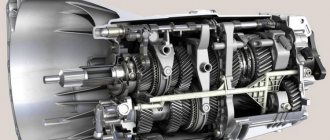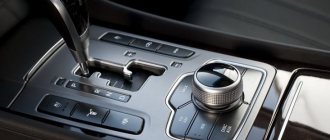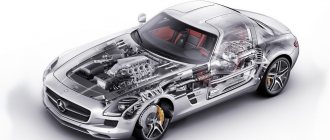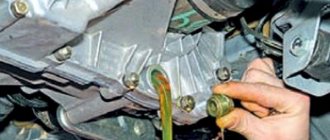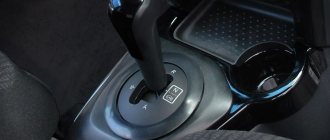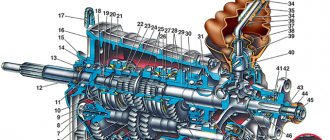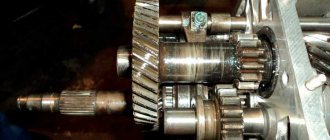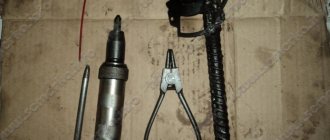The transmission elements of any car are designed to ensure the transmission of engine torque to the drive wheels. At the dawn of the automotive industry, devices providing such a function were not highly efficient due to the simplicity of their design. The modernization of the presented components led to the fact that it was possible to achieve smooth gear shifting without loss of power and dynamic characteristics of the car.
The clutch plays a key role in transmitting torque. This complex knot underwent a number of changes before becoming what we are used to seeing it now.
Many of the improvements that found their way into the civilian automotive industry were borrowed from racing cars. One of them includes the so-called double clutch, which we will talk about in this article.
The design and principle of operation of a car clutch
A clutch is a transmission mechanism that transmits torque from the engine to the gearbox through friction. It also allows you to briefly disconnect the engine from the transmission and reconnect them smoothly. There are quite a few types of clutches. They differ in the number of driven disks (single disk, double disk or multi-disk), the type of operating environment (dry or wet) and the type of drive. Different types of clutches have their respective advantages and disadvantages, but the most common on modern cars is the single-plate dry clutch, either mechanically or hydraulically driven.
Clutch elements
The standard clutch used on most vehicles with a manual transmission includes the following main elements:
- The engine flywheel is the drive disk.
- Driven clutch disc.
- Clutch basket - pressure plate.
- Clutch release bearing.
- Clutch release clutch.
- Clutch fork.
- Clutch drive.
Friction linings are installed on the clutch driven disc on both sides. Its function is to transmit torque due to friction. A spring torsional vibration damper built into the disk body softens the connection with the flywheel and dampens vibrations and loads from uneven engine operation.
Layout of the clutch disc, basket and release bearing with release clutch
The pressure plate and diaphragm spring acting on the driven clutch disc are assembled into a single unit called the “clutch basket”. The clutch driven disc is located between the pressure plate and the flywheel and is connected to the transmission input shaft using splines along which it can move.
The diaphragm spring of the basket can be of either a push or pull principle of operation. The difference is in the direction of application of force from the clutch drive: to the flywheel or from the flywheel. The design feature of the extension spring allows the use of a basket whose thickness is much smaller. This makes the unit as compact as possible.
Mitsubishi
Here the prices are no longer the same as in previous cases. For example, for a Mitsubishi Lancer, the LuK 620316900 clutch kit costs 14-15 thousand rubles, and LuK 623356809 is already 43-44 thousand. There is also a cheaper option - the KraftTech W20200F set for the same model costs from 5-6 thousand rubles. (bearing, basket and disc). The cost of clutch repair work, which includes removal/installation and cleaning, is 8-9 thousand rubles. If you take the clutch as a kit from LuK, the repair cost can be 53 thousand rubles. and more. If you do not need a set, but some individual parts, the amount may be reduced - it all depends on the manufacturer.
Clutch kit LuK 620316900 for Mitsubishi Lancer. Average price: 14622 rub. Photo: YandexMarket.
Principle of operation
The principle of operation of the clutch is based on a rigid connection between the clutch driven disc and the engine flywheel due to the frictional force generated by the force created by the diaphragm spring. The clutch has two modes: “on” and “off”. Most of the time the driven disk is pressed against the flywheel. Torque from the flywheel is transmitted to the driven disk, and from it through a splined connection to the input shaft of the gearbox.
Diaphragm spring operation diagram
To disengage the clutch, the driver presses the pedal, which is connected to the fork by a mechanical or hydraulic drive. The fork moves the release bearing, which, by pressing on the ends of the petals of the diaphragm spring, stops its pressure on the pressure plate, and it, in turn, releases the driven one. At this point, the engine is disconnected from the transmission.
Sharp starts and low flights
“Racers” who practice starting with two pedals on a civilian car should remember that there is a protective mechanism that prevents the clutch disc from closing with the flywheel. The turnover simply will not grow. If such protection is not provided, then the discs will close, but they will slip, since the brake pedal will not allow the car to move.
Servicemen also warn about the negative impact of driving with frequent acceleration and braking - the gearbox control may not keep up with the frequent changes in the mood of the driver, who abruptly and alternately presses the accelerator and brake pedals. If you decide to indulge in aggressive aerobatics, then choose manual mode.
Types of clutch
Dry clutch
The principle of operation of this type of clutch is based on the friction force that arises from the interaction of dry surfaces: drive, driven and pressure disks. This ensures a tight connection between the engine and gearbox. A dry single-plate clutch is the most common type used on most cars with a manual transmission.
Wet clutch
This type of clutch involves the operation of the rubbing surfaces in an oil bath. Compared to dry, this scheme ensures smoother contact of the discs; the unit is cooled more efficiently due to fluid circulation and can transmit more torque to the transmission.
Double wet clutch
The wet circuit is usually used on modern dual-clutch robotic gearboxes. The peculiarity of the operation of such a clutch is that the even and odd gears of the gearbox are supplied with torque from separate driven disks. The clutch drive is hydraulic, electronically controlled. Gear shifting occurs with constant transmission of torque to the transmission without interruption in the power flow. This design is more expensive and difficult to manufacture.
Dry double-disc clutch
A dry double-disc clutch involves the presence of two driven discs and an intermediate spacer between them. This scheme is capable of transmitting more torque with the same dimensions of the clutch mechanism. In itself, it is easier to produce compared to wet. Typically used on trucks and cars with particularly powerful engines.
Dual mass flywheel clutch
The dual mass flywheel consists of two parts. One of them is connected to the engine, the second to the driven disk. Both components of the flywheel have a slight free play relative to each other in the plane of rotation and are connected by springs to each other.
Dual mass flywheel diagram
A special feature of the dual-mass flywheel clutch is the absence of a spring-loaded torsional vibration damper in the driven disc. The vibration damping function is built into the flywheel design. In addition to transmitting torque, it most effectively smoothes out vibrations and loads arising from uneven engine operation.
The bigger, the better
A modern “robot” with two clutches shows excellent results in terms of shift speed, but its spread is primarily due to reduced fuel consumption. According to the VW concern, using the example of a Golf with a 122-horsepower TSI engine, the version with DSG consumes on average 8.7% less gasoline than a similar one with a conventional “mechanics”. And compared to a hydromechanical “automatic machine,” the “robot’s” gain reaches an impressive 22%. Reducing fuel consumption means increasing environmental performance - the less fuel a car burns, the less carbon dioxide and toxic substances it emits. Improving the environmental friendliness of a car is a very fashionable topic now, and one of the ways to achieve success in this direction is to increase the number of steps. This trend has not bypassed dual-clutch transmissions. Seven gears is no longer considered “a lot”. While VW decided that there was no point in developing a 10-speed DSG, Acura still created a nine-speed one for the NSX sports coupe. Moreover, Honda has patented an 11-speed gearbox with three (!) clutches, probably hoping to achieve super-green performance in the future.
Clutch life
The clutch life mainly depends on the vehicle's operating conditions, as well as the driver's driving style. On average, the clutch service life can reach 100-150 thousand kilometers. As a result of natural wear that occurs when the discs come into contact, the friction surfaces wear out and require replacement. The main reason is disc slippage.
The double-disc clutch has a longer service life due to the increased number of working surfaces. The clutch release bearing is engaged whenever the connection between the engine and transmission is broken. Over time, all the lubricant in the bearing is produced and loses its properties, as a result of which it overheats and fails.
DSG 6 and DSG 7
This transmission is installed on vehicles manufactured by the VW Group. Brands "Volkswagen", "Skoda" and others. The most common causes of failure of a “wet” DSG 6 clutch:
- ✅wear of friction clutches
- ✅ destruction of bearings
- ✅ failures in the electronic unit
The cost of the original DSG 6 clutch is around 27-32 thousand rubles. Add here the work of removal, installation, adaptation (16-18 thousand rubles), a set of gaskets, filters and oil (VAG. 1 l - 2400 rubles, full filling 6.9 l, total 16 thousand rubles). That is, the minimum cost is 60 thousand rubles.
For DSG 7 repairs, prices are also not particularly attractive. For example, the cost of a clutch kit 0AM 198 142 AA averages 43-47 thousand rubles, but there is another, inexpensive set - DSG-7 SACHS 3000943001, which will cost 43-44 thousand rubles. The cost of work (with removal, installation, adaptation) is 8-9 thousand rubles. Total: minimum 51 thousand rubles.
Double clutch, description and principle of operation
Modern cars are equipped not only with improved gearboxes, but also with double clutches. This device is one of the best today; we’ll tell you about the principle of operation and its design.
Many current robotic transmissions have a dual clutch. In addition to the standard function of the clutch, it provides pre-selection of the next gear when the previous one is engaged. This choice is achieved thanks to the alternate operation of friction clutches.
Thanks to this well-established operation, torque is continuously transmitted to the drive wheels from the engine.
Type of mechanisms
The double clutch, as is already clear, works in concert with the gearbox. In dual-clutch automatic transmissions, different clutches are used for odd and even gears. We can say that, in essence, these are two different boxes that are located in the same case and work as one whole.
The use of a double clutch was first mentioned in 1980 by Audi and Porsche, which used their designs for their own sports cars. Nowadays it has migrated to production models and is called:
- Speedshift from Mercedes-Benz;
- Twin Clutch SST for Mitsubishi;
- S-Tronic for Audi;
- 7DT - Porsche;
- Powershift - Ford;
- BMW - M DCT;
- DSG - Volkswagen.
This is not yet a complete list of manufacturers who use similar technology for their cars.
Despite the name of the automaker's company, it is completely different. Due to the complexity of the technology of operation of such a mechanism, manufacturers are distinguished:
- ZF for Porsche cars;
- Luk - for Volkswagen as a dry clutch;
- BorgWarner - for Volkswagen as a wet clutch;
- Ricardo is the most famous for the Bugatti Veyron;
- Getrag – for Chrysler, Volvo, Mercedes-Benz, Ferrari, Ford cars.
It often happens that automakers combine spare parts and individual systems from different manufacturers. For example, BMW uses a double clutch from BorgWarner and a gearbox from Getrag.
Drawing conclusions
When deciding to buy a dual-clutch car, think about the pros and cons and decide which aspects are your priority. Are dynamics, comfort and smoothness, lack of jerking when changing gears and fuel consumption so important to you? Or you are not ready to pay for expensive maintenance and repairs due to the complexity of the design and the specific operating mode. There are also not many professional auto repair shops that service this type of transmission.
Regarding wet and dry clutches, the answer to which is better will also not be clear. It all depends on the individual characteristics of the vehicle, as well as the power of its engine.
"Wet" double
There are two types of clutch, dry and wet (also multi-plate in oil). The so-called “wet” has better cooling. Most often it is installed on gearboxes with a torque of 250 Nm and above. An example would be the Bugatti Veyron, whose torque reaches 1250 Nm.
The second set of discs is mounted on separate hubs, which are located on the input shaft of the corresponding row of gears. In the normal position the mechanism will be open. As for the closure, this is done thanks to hydraulic cylinders controlled by an electrohydraulic module. The disks take their initial position due to springs.
Depending on the design of the double clutch, the friction disc packs can be arranged differently, concentrically or parallel. Concentrically, when the couplings are located in the same plane and perpendicular to the input shaft. In this position the couplings are more compact. Typically used in gearboxes with front-wheel drive and a transverse engine.
As a rule, the internal clutch is responsible for shifting even-numbered gears, and the external clutch is responsible for shifting odd-numbered gears. It becomes clear that such a set is designed to transmit high torque.
Parallel - when the couplings are located one behind the other. As a rule, this arrangement is used for rear-wheel drive cars.
Dry double
As mentioned above, the wet clutch is set for torque from 250 Nm. As for the dry clutch, the maximum torque for it is 250 Nm. The effectiveness of this clutch is achieved due to the minimal loss of unit power to drive the oil pump.
In the normal position the mechanism is open. The whole principle of “dry” operation is based on the transmission of torque to the positioned clutch disc from the drive disc, and then to the corresponding input shaft of the gearbox. As a rule, each dry clutch operates independently of each other, which gives greater reliability.
When the clutch closes, the lever presses the release bearing against the diaphragm spring, which in turn transmits all the force to the pressure plate, and then to the clutch disc. The clutch disc itself is pressed against the drive disc, after which the torque is supplied to the gearbox input shaft.
Take your time when switching
Switching the lever between the main modes “parking” and “drive” should occur while the car is stationary with the brake pedal fully depressed. You should start driving after the gear is fully engaged.
It is not recommended to pull the DSG selector while changing modes - everything should be done not hastily, but smoothly, since the electronics of the box need 1-2 seconds to understand what they want from it. There is information that such a simple method is enough to increase the resource of the unit.
Graphic diagrams of wet and dry clutches
Wet double clutch diagram:
- Input hub;
- Clutch hub first;
- Clutch hub second;
- Leading disk;
- Clutch disc pack second;
- First clutch disc pack;
- Diaphragm spring;
- Piston;
- Hydraulic cylinder of the first clutch;
- Primary shaft for row 1;
- Primary shaft for row 2;
- Main hub;
- Piston;
- Coil spring;
- Second clutch hydraulic cylinder.
Dry double clutch diagram:
- input shaft 1;
- release bearing 2;
- diaphragm spring 2;
- pressure plate one;
- master disk;
- dual-mass flywheel;
- clutch disc 2;
- pressure plate 2;
- clutch disc 1;
- diaphragm spring 1;
- release bearing 1;
- input shaft 2.
Video of how the S-Tronic system works on Audi:
Source of the article: https://fastmb.ru/auto_shem/1038-dvoynoe-sceplenie-opisanie-i-princip-raboty.html
